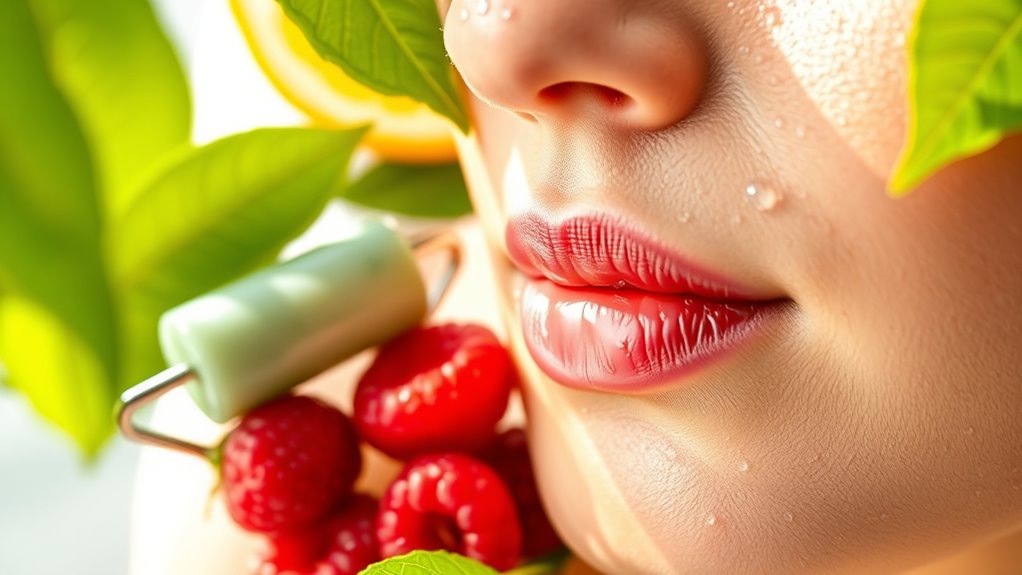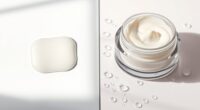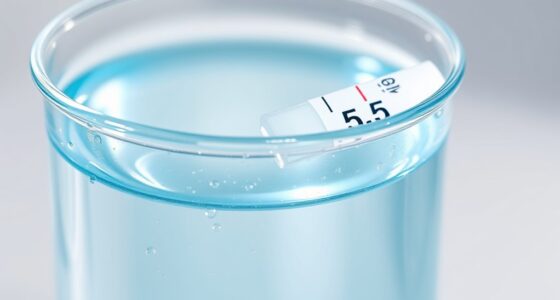Natural acids, like glycolic and lactic acid, can boost your skin’s glow without harsh chemicals. Glycolic acid gently exfoliates, improving elasticity and reducing fine lines, while lactic acid hydrates and evens out skin tone, perfect for sensitive skin. Salicylic acid, on the other hand, cleans deep pores and combats acne. These natural solutions keep your skin radiant and fresh. Discover how to incorporate these acids into your routine for even better results.
Key Takeaways
- Natural acids, like AHAs and BHAs, provide gentle exfoliation, enhancing skin texture and appearance without harsh chemicals.
- Glycolic acid effectively removes dead skin cells, unclogs pores, and improves skin elasticity for a more youthful look.
- Lactic acid offers gentle exfoliation and hydration, making it ideal for sensitive skin types while brightening the complexion.
- Salicylic acid penetrates deep into pores, reducing inflammation and clearing impurities, making it perfect for acne-prone skin.
- Incorporating hyaluronic acid helps retain moisture, reducing fine lines and promoting a plump, radiant complexion.

If you’re looking to achieve glowing skin, incorporating natural acids into your skincare routine can make a significant difference. These acids, derived from fruits, plants, and other natural sources, offer a range of benefits without the harsh chemicals found in many commercial products. You’ll find that both Alpha Hydroxy Acids (AHAs) and Beta Hydroxy Acids (BHAs) play essential roles in skin health, making them excellent additions to your regimen.
Glycolic acid, a popular AHA, is known for its ability to gently exfoliate your skin. It removes dead skin cells, revealing a fresher and more radiant complexion underneath. By improving skin elasticity and reducing fine lines, glycolic acid also fights signs of aging while helping to unclog pores and diminish acne scars. Plus, its hydrating properties mean it can retain moisture, keeping your skin plump and vibrant. Regular use of glycolic acid reduces fine lines, enlarged pores, and hyperpigmentation. Hydrocolloid patches are also effective for treating localized acne and can complement your routine by targeting blemishes. Additionally, omega-3 fatty acids found in chia seeds can help promote healthy skin through their anti-inflammatory properties. The soluble fiber in chia seeds also aids in digestive health, which can reflect positively on your skin’s appearance.
Glycolic acid gently exfoliates, revealing radiant skin while combating aging signs and unclogging pores for a smoother complexion.
Lactic acid is another AHA that offers a gentler touch, making it suitable for sensitive skin types. It not only provides gentle exfoliation but also hydrates your skin, leaving it smooth and bright. You’ll appreciate how it improves skin tone while minimizing fine lines, thanks to its plant-derived origins.
If acne is a concern for you, salicylic acid, a BHA, could be your go-to solution. Known for deep pore cleansing, it effectively clears out blackheads and reduces inflammation. Salicylic acid penetrates deeper layers of skin, providing thorough exfoliation without the need for harsh scrubbing. You can find it in various concentrations, allowing you to choose the right strength for your needs.
Hyaluronic acid is an essential humectant that can hold vast amounts of water, making it a must-have for moisture retention. Not only does it help reduce fine lines and wrinkles, but it also offers antioxidant properties that protect against environmental stressors. The hydration it provides leaves your skin feeling smooth and plump.
Don’t overlook essential fatty acids like linoleic and alpha-linolenic acids, which are crucial for skin health. They promote healthy shedding and renewal while balancing dry or oily skin conditions. Their soothing properties calm stressed skin, reducing irritation.
Before diving into natural acids, remember to patch test any new products. Higher concentrations might increase irritation risks, so start slow. Consulting with a dermatologist can help tailor your approach to your unique skin needs.
Embrace the power of natural acids, and watch your skin glow!
Frequently Asked Questions
Can Natural Acids Cause Allergic Reactions on Sensitive Skin?
Yes, natural acids can cause allergic reactions on sensitive skin.
You might experience symptoms like redness, itching, or swelling if your skin reacts to ingredients like salicylic or citric acid.
Even though these acids are derived from natural sources, they’re still potent and can irritate your skin.
It’s essential to patch test new products to identify any potential allergens and avoid reactions that could leave your skin feeling uncomfortable.
How Long Does It Take to See Results From Natural Acids?
Did you know that 80% of people see noticeable skin improvements within just 4-6 weeks of using natural acids?
If you’re incorporating them into your routine, you can expect instant hydration and slight brightening right away.
In about 2-4 weeks, you’ll likely notice smoother skin and less acne.
For more significant changes, like reduced fine lines and even skin tone, stick with it for 3-6 months for the best results.
Are Natural Acids Safe for Pregnant or Breastfeeding Women?
When considering natural acids during pregnancy or breastfeeding, you need to be cautious.
Glycolic and lactic acids are generally safe in low concentrations, while salicylic acid isn’t recommended due to potential risks.
Hyaluronic and azelaic acids are safe and effective options for hydration and acne.
Always consult your healthcare provider before starting any new skincare regimen, as ingredient knowledge and concentration levels are crucial for minimizing risks to you and your baby.
Can I Use Natural Acids With Other Skincare Ingredients?
Imagine your skincare routine as a symphony, where each ingredient plays its role.
You can use natural acids with other ingredients, but be cautious. Mixing glycolic acid with hyaluronic acid can enhance hydration, while salicylic acid and retinol can amp up effectiveness.
However, avoid combining Vitamin C with AHAs or BHAs to prevent irritation.
Always patch test first to ensure your skin sings in harmony, not discord.
Happy glowing!
What Is the Difference Between AHA and BHA in Natural Acids?
AHAs and BHAs serve different purposes in skincare.
AHAs, like glycolic and lactic acid, are water-soluble and excel at exfoliating the skin’s surface, improving texture and stimulating collagen production.
BHAs, primarily salicylic acid, are oil-soluble, allowing deeper penetration into pores, making them great for treating acne and unclogging pores.
If you’re looking for surface exfoliation, go for AHAs; for deeper cleansing and acne treatment, choose BHAs.
Conclusion
Incorporating natural acids into your skincare routine can truly transform your complexion. Did you know that 70% of people notice improved skin texture after just four weeks of using products with natural acids? By choosing these gentle alternatives, you’re not only promoting a radiant glow but also caring for your skin without harsh chemicals. So, why not give your skin the love it deserves? Embrace the power of nature for a luminous, healthy look!










